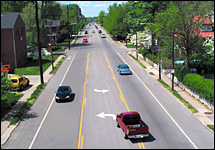MLUI / Articles from 1995 to 2012 / The Asphalt Rebellion:
The Asphalt Rebellion:
Vibrant and beautiful, not fast and ugly
August 20, 2004 |
Great Lakes Bulletin News Service
 | |
| Courtesy of Kentucky | |
So called “traffic calming” converted this road in Lexington, Ky., from four lanes to three and added bike paths and left turn lanes. Traffic speeds dropped, making the road safer for drivers and the sidewalks far more attractive and safe for pedestrians. |
Americans see auto traffic as an inevitable by-product of modern life. Some mourned the loss of the calm and quaintness of life before the automobile, but most seemed thrilled about going more places in less time. So we have built ever more, ever faster roads, including the interstate highway system — the largest, most expensive public works project in history — and spent billions of dollars widening roads and ripping up millions of trees, tens of thousands of houses, and thousands of communities.
But now citizens are fighting back. They are working to restore peace and community to their neighborhoods, where walking is now often a frustrating, unpleasant, and dangerous pastime, and where speeding drivers imperil their children, pets, and their elderly and disabled friends.
It is traffic speed, not volume, that most threatens pedestrians. For example, a British study found that 40-miles-per-hour cars are 17 times more lethal to pedestrians than 25-mile-per-hour cars.
Children are the biggest losers, says Australian David Engwicht, who fought a road expansion in his neighborhood and wrote a book about entitled Reclaiming Our Cities and Towns: Better Living with Less Traffic. He notes that kids cannot play in the streets anymore without adult supervision. They are reduced to watching Sesame Street, "a make-believe street where children play safely and go exploring."
For thousands of years, Engwicht writes, streets were places for people to socialize, as well as pathways for carriages and pack animals. Today, streets are only for automobiles, thanks mostly to several generations of transportation planners who focused exclusively on speedy vehicles and regarded pedestrians and bicyclists as nuisances.
Lowering speed limits is one logical response. But people pay less attention to speed limits than to the look of a street in choosing their speed: Wide, open streets encourage them to zoom. Now many people are heralding a new idea — traffic calming — as a better way to slow drivers down. It works by visually reminding drivers of people who are on foot, on bicycles, and in wheelchairs or baby strollers. Speed bumps, narrowed streets, four-way stops, brightly painted crosswalks, on-street parking, median strips, slightly raids crosswalks, and curbs that extend into intersections all make streets safer for pedestrians.
Opponents may claim that traffic calming simply shoves speeding traffic onto someone else's street, but studies show exactly the opposite: It decreases both speed and traffic. People make fewer auto trips, either by doing more errands per trip or by switching to biking, walking, or transit.
Coast to coast, Americans are embracing traffic calming — in Boston, plans were abandoned for a 10-lane highway in favor of a four-lane boulevard; in California, people are mapping safe walking routes to school. After 75 years as pawns in the transportation system, pedestrians are asserting their rights to enjoy the health, fun, and community-building qualities of walking.
"It's easy to become a pedestrian advocate," notes Ellen Vanderslice, whose harrowing attempts to cross a busy neighborhood street with two toddlers in Portland, Ore., turned her into an activist. "Find people who feel the same way and get a group together."
Ms. Vanderslice’s is part of what Governing magazine executive editor Alan Ehrenhalt calls "the asphalt rebellion" against “an obscure but immensely important book: A Policy on Geometric Design of Highways and Streets." The book was for decades the bible for traffic engineers, who invoked it with Ten Commandments authority to reject concerns about neighborhood projects.
Asphalt rebels contend that aesthetics, property values, and community life don't figure in that bible’s calculations — only how much pavement it takes to keep traffic moving quickly. So when engineers insist that safety always guides their decisions, asphalt rebels point out that many road widenings make travel far more dangerous for bicyclists, pedestrians, children, and old people. They point out that in New York City, for example, the second leading cause of death for children ages five to fourteen is being hit by a car. They question whether designing streets to accommodate illegal speeds, as engineers often do, actually promotes safety. They point to studies that demonstrate that narrow streets are the safer streets. For example, Longmont, Colo., looked at 20,000 accidents over 8 years and found that "as street width widens, accidents per mile per year increase exponentially." This defies the traditional views that narrow streets are safety hazards.
Prodded by environmentalists, neighborhood groups, preservationists, parents, and other asphalt rebels, many communities are rethinking traffic issues. Eugene, Ore., once required streets to be at least 28 feet wide; it now allows some to be just 20 feet wide. Wellesley, Mass., nixed a widening plan for its main street, and instead widened the sidewalks. Even auto-happy southern California’s San Bernardino, Riverside, and Beverly Hills narrowed major commercial streets. And Vermont frequently allows officials to relax the design bible’s standards.
Even some traffic engineers are questioning whether moving cars quickly is a community’s top goal. Orlando traffic engineer Walter Kulash says, "When you ask the public, 'Would you rather take twelve more seconds to get where you're going and have this be a tree-lined, wonderful street?' the answer is always, 'We want it to be vibrant and beautiful, not fast and ugly.'"
Jay Walljasper is executive editor of Ode magazine and strategic communications associate for the Project for Public Spaces. Reach him at jay@odemagazine.com.





